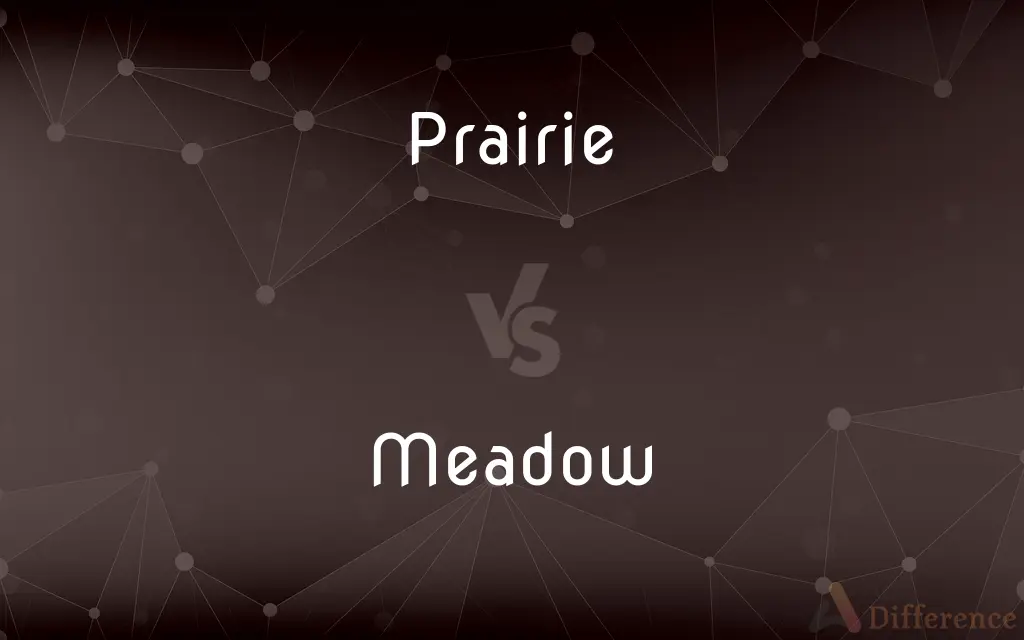Prairie vs. Meadow — What's the Difference?
By Tayyaba Rehman & Fiza Rafique — Updated on March 19, 2024
Prairies are expansive grasslands with few trees, found mainly in North America, known for their deep-rooted grasses, whereas meadows are smaller grassy areas that can be found worldwide, often featuring a mix of grasses and wildflowers.

Difference Between Prairie and Meadow
Table of Contents
ADVERTISEMENT
Key Differences
Prairies are vast, often found in regions like North America, characterized by their extensive grasslands with deep-rooted grasses that are adapted to extreme weather conditions and wildfires. Meadows, on the other hand, are smaller grassy areas that can occur naturally or be created by human activities.
The soil composition and moisture levels in prairies and meadows also differ significantly. Prairies often have rich, fertile soils that have built up over thousands of years due to the decay of deep-rooted grasses. This makes them ideal for agriculture once converted, although this conversion can lead to loss of biodiversity and soil erosion. Meadows, however, may have varying soil types, from wet and marshy to dry and sandy, depending on their location and the local climate conditions.
While prairies are adapted to withstand drought and fire, with species that can recover quickly after such events, meadows may be more susceptible to changes in weather and climate. Meadows often require specific conditions to thrive and can be sensitive to environmental changes, including changes in land use and the introduction of non-native plant species.
Both prairies and meadows are important habitats for wildlife, offering food and shelter to a wide range of species. However, the specific species found in each can vary greatly. Prairies are known for hosting large mammals like bison and pronghorn, as well as a variety of grassland birds. Meadows, with their diverse plant life, attract a wide array of insects, birds, and small mammals, making them key to local biodiversity.
Comparison Chart
Location
Mainly in North America
Worldwide
ADVERTISEMENT
Size
Large, expansive
Smaller, can be natural or man-made
Vegetation
Dominated by grasses, few trees
Mix of grasses, wildflowers, sometimes shrubs
Soil Type
Rich, fertile, deep
Varies; can be wet, marshy, or dry and sandy
Adaptations
Adapted to drought and fire
Seasonal, sensitive to environmental changes
Role
Soil conservation, carbon sequestration
Supporting pollinators
Wildlife
Large mammals, grassland birds
Insects, birds, small mammals
Compare with Definitions
Prairie
Deep-rooted grasses.
Prairie plants feature deep roots that help them survive drought and contribute to soil health.
Meadow
Seasonal changes.
The appearance of the meadow changes with the seasons, attracting different pollinators.
Prairie
Supports biodiversity.
Prairies are home to a variety of species, from bison to prairie dogs.
Meadow
Sensitive to environmental changes.
Meadows can be dramatically affected by alterations in land use.
Prairie
Expansive grassland.
The vast prairies of North America stretch for miles, dominated by tall grasses.
Meadow
Smaller grassy area.
The meadow was a burst of color with wildflowers and grasses.
Prairie
Adapted to extreme weather.
Prairies are naturally resilient, recovering quickly from wildfires.
Meadow
Mix of vegetation.
Meadows can include a diverse range of grasses and flowering plants.
Prairie
Soil conservation.
The dense root systems of prairie grasses prevent soil erosion effectively.
Meadow
Attracts diverse wildlife.
The meadow was alive with bees, butterflies, and birds, drawn to its variety of plants.
Prairie
Prairies are ecosystems considered part of the temperate grasslands, savannas, and shrublands biome by ecologists, based on similar temperate climates, moderate rainfall, and a composition of grasses, herbs, and shrubs, rather than trees, as the dominant vegetation type. Temperate grassland regions include the Pampas of Argentina, Brazil and Uruguay, and the steppe of Ukraine, Russia and Kazakhstan.
Meadow
A meadow is an open habitat, or field, vegetated by grasses, herbs, and other non-woody plants. Trees or shrubs may sparsely populate meadows, as long as these areas maintain an open character.
Prairie
An extensive flat or rolling area dominated by grasses, especially the grasslands that once covered much of central North America.
Meadow
A piece of grassland, especially one used for hay
A meadow ready for cutting
143 acres of meadow and pasture
Prairie
An extensive area of relatively flat grassland with few, if any, trees, especially in North America.
Meadow
A tract of grassland, either in its natural state or used as pasture or for growing hay.
Prairie
An extensive tract of level or rolling land, destitute of trees, covered with coarse grass, and usually characterized by a deep, fertile soil. They abound throughout the Mississippi valley, between the Alleghanies and the Rocky mountains.
From the forests and the prairies,From the great lakes of the northland.
Meadow
A field or pasture; a piece of land covered or cultivated with grass, usually intended to be mown for hay.
Prairie
A meadow or tract of grass; especially, a so called natural meadow.
Meadow
Low land covered with coarse grass or rank herbage near rivers and in marshy places by the sea.
The salt meadows near Newark Bay
Prairie
A treeless grassy plain
Meadow
A tract of low or level land producing grass which is mown for hay; any field on which grass is grown for hay.
Meadow
Low land covered with coarse grass or rank herbage near rives and in marshy places by the sea; as, the salt meadows near Newark Bay.
Meadow
Of or pertaining to a meadow; of the nature of a meadow; produced, growing, or living in, a meadow.
Meadow
A field where grass or alfalfa are grown to be made into hay
Common Curiosities
What is a meadow?
A meadow is a smaller, often lush grassy area that can include a mix of grasses and wildflowers, found worldwide.
Are prairies found worldwide?
While grasslands are found worldwide, prairies specifically refer to the grasslands of North America.
How do prairies and meadows differ in size?
Prairies are vast and expansive, while meadows are generally smaller and can vary in size.
What is a prairie?
A prairie is a large, open grassland with few trees, characterized by deep-rooted grasses adapted to dry conditions and wildfires.
How do prairies contribute to soil health?
The deep roots of prairie grasses help in soil conservation and carbon sequestration, enhancing soil health.
Are meadows affected by seasonal changes?
Yes, meadows undergo seasonal changes, which affect their appearance and the types of wildlife they attract.
How do meadows support wildlife?
Meadows provide habitat and food for insects, birds, and small mammals, contributing to local ecosystems.
What makes meadows important for biodiversity?
Meadows support a wide range of pollinators and wildlife due to their diverse plant life.
Can meadows be man-made?
Yes, meadows can be natural or created by human activities, such as through the management of land for conservation purposes.
What wildlife is typically found in prairies?
Prairies support large mammals like bison and a variety of grassland birds.
Can the introduction of non-native species affect meadows?
Yes, non-native plants can alter the ecological balance of meadows, affecting native species.
What types of vegetation are found in prairies?
Prairies are dominated by grasses and have very few trees, adapted to the local climate.
Why are prairies important for agriculture?
Converted prairies offer fertile soils for agriculture, though this can impact their ecological integrity.
What conservation efforts are important for prairies and meadows?
Protecting these areas from development, managing invasive species, and restoring native vegetation are key conservation strategies.
What challenges do prairies face?
Conversion to agriculture and urban development are major challenges, leading to habitat loss and reduced biodiversity.
Share Your Discovery

Previous Comparison
Key vs. Keycard
Next Comparison
Dip vs. DiveAuthor Spotlight
Written by
Tayyaba RehmanTayyaba Rehman is a distinguished writer, currently serving as a primary contributor to askdifference.com. As a researcher in semantics and etymology, Tayyaba's passion for the complexity of languages and their distinctions has found a perfect home on the platform. Tayyaba delves into the intricacies of language, distinguishing between commonly confused words and phrases, thereby providing clarity for readers worldwide.
Co-written by
Fiza RafiqueFiza Rafique is a skilled content writer at AskDifference.com, where she meticulously refines and enhances written pieces. Drawing from her vast editorial expertise, Fiza ensures clarity, accuracy, and precision in every article. Passionate about language, she continually seeks to elevate the quality of content for readers worldwide.














































